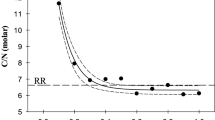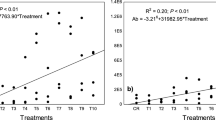Abstract
The observational and experimental approaches to ecological studies are outlined and contrasted. Most studies involving benthic diatoms are still at the observational stage. Community analyses are interpreted in relation to physico-chemical variables, but without reference to the intrinsic growth characteristics of the species or to biological interactions. By allowing separate investigation of the effects of chosen variables under controlled conditions, culture studies permit field predictions to be tested and our understanding of the constraints on growth of particular species to be improved.
Results of culture experiments on four benthic diatom species grown under contrasting light, temperature, and pH regimes are presented and discussed in relation to their field distributions. Synedra ulna showed a positive response to both light and temperature; Meridion circulare was more sensitive to raised water temperature at higher light intensity; Pinnularia viridis and Eunotia exigua grew over wider ranges of temperature and pH than recorded from published data. The experimental results indicate that distribution data provide only partial information on ecological range; growth in the field may be constrained by one or more factors and their interactions.
Whereas analysis of field data is a correlative exercise, an experimental approach allows investigation of the physiological responses contributing to the survival of species and the demonstration of causal relationships.
Similar content being viewed by others
References
Alles, E., M. Nörpel & H. Lange-Bertalot, 1991. Zur Systematik and Ökologie charakteristischer Eunotia-Arten (Bacillariophyceae) in elektolytarmen Bachoberläufen. Nova Hedwigia 53: 171–213.
Coste, M., 1990. Diagnostic biologique de la qualité des eaux continentales: les principales méthodes microfloristiques. D. E. A.: Sciences et techniques de l'environnement. Module 8: Hydroéiologie Hydrobiologie de la qualité de l'eau. 42 pp.
Cox, E. J., 1990. Studies on the algae of a small softwater stream. I. Occurrence and distribution with particular reference to the diatoms. Arch. Hydrobiol./Suppl. 83: 525–552.
Cox, E. J., in press. Ecological tolerances and optima - real or imaginary? Verh. Internat. Verein. Limnol.
Descy, J.-P., 1984. Ecologie et distribution de diatomées benthiques dans le bassin beige de la Meuse. Inst. Roy. des Sci. Nat. de Belg., Doc. Trav. 18: 1–25.
Durbin, E. G., 1974. Studies on the autecology of the marine diatom Thalassiosira nordenskioldii Cleve. 1. The influence of daylength, light intensity, and temperature on growth. J. Phycol. 10: 220–225.
Grime, J. P., W. Hall, R. Hunt, A. M. Neal, W. Ross-Fraser & F. Sutton, 1989. A new development of the temperature-gradient tunnel. Ann. Bot. 64: 279–287.
Guillard, J. L. L., 1973. Division rates. In J. R. Stein, (ed.), Handbook of phycological methods. Culture methods and growth measurements. Cambridge University Press: 289–311.
Guzkowska, M. A. J. & F. Gasse, 1990. Diatoms as indicators of water quality in some urban lakes. Freshw. Biol. 23: 233–250.
Holt, M. G. & T. J. Smayda, 1974. The effect of daylength and light intensity on the growth rate of the marine diatom Detonula confervacea (Cleve) Gran. J. Phycol. 10: 231–237.
Krejci, M. E. & R. L. Lowe, 1987. The seasonal occurrence of macroscopic colonies of Meridion circulare (Bacillariophyceae) in a spring-fed brook. Trans. Am. Microsc. Soc. 106: 173–178.
Lowe, R. L., 1974. Environmental requirements and pollution tolerances of freshwater diatoms. Report 670/4–74–005. EPA, Cincinnati, Ohio. 334 pp.
Lowe, R. L., S. W. Golladay & J. R. Webster, 1986. Periphyton response to nutrient manipulation in streams draining clear-cut and forested watersheds. J. N. Am. Benthol. Soc., 5: 221–229.
Lund, J. W. G., 1950. Studies on Asterionella. 2. Nutrient depletion and the spring maximum. J. Ecol. 38: 1–35.
Mayr, E., 1988. Toward a new philosophy of biology. Harvard University Press, Cambridge, Mass. 564 pp.
Nichols, H. W., 1973. Growth media — freshwater. In J. R. Stein, (ed.), Handbook of phycological methods. Culture methods and growth measurements. Cambridge University Press, Cambridge: 7–24.
Sober, E., 1984. The nature of selection: evolutionary theory in philosophical focus. MIT Press, Cambridge, Mass. 383 pp.
Sommer, U., 1987. Factors controlling the seasonal variation in phytoplankton species composition - A case study for a deep, nutrient rich lake. Prog. Phycol. Res. 5: 123–178.
Sullivan, M. J., 1982. Distribution of edaphic diatoms in a Mississippi salt marsh: a canonical correlation analysis. J. Phycol. 18: 130–133.
Sullivan, M. J. & C. A. Moncreiff, 1988. A multivariate analysis of diatom community structure and distribution in a Mississippi salt marsh. Bot. Mar. 31: 91–93.
Tilman, D., 1981. Tests of resource competition theory using four species of Lake Michigan algae. Ecology 62: 802–815.
Tilman, D. & S. S. Kilham, 1976. Phosphate and silicate uptake and growth kinetics of the diatoms Asterionella formosa and Cyclotella meneghiniana in batch and semicontinuous culture. J. Phycol. 12: 375–383.
Author information
Authors and Affiliations
Rights and permissions
About this article
Cite this article
Cox, E.J. Freshwater diatom ecology: developing an experimental approach as an aid to interpreting field data. Hydrobiologia 269, 447–452 (1993). https://doi.org/10.1007/BF00028042
Issue Date:
DOI: https://doi.org/10.1007/BF00028042




